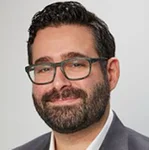 |
| Chris Gasiewski |
Social audio has risen faster than summer gas prices, capitalizing on a strong audio establishment and thirst to participate in live discussion. Clubhouse, which gained notoriety and a massive following during the COVID-19 pandemic, surpassed 10 million active users in May and was recently valued at $4 billion, leading the drive to mirror that success among social platforms to a fever pitch.
Twitter, Facebook and LinkedIn are now all in, continuously working on launching or improving on an audio product. As the social audio movement continues, the question is, will it replace podcasting as the most powerful form of audio consumption?
Put simply: No. Both offerings can and should coexist as effective tools to build trust, develop personalized connections and fortify relationships with your audience. For healthcare specifically—where consumer trust reigns—these platforms can accelerate organizational storytelling, offering diverse perspectives from patients, physicians, nurses, executives and researchers.
While each offering is unique, both can elevate your brand. Here’s how.
Different formats for different audiences
Social audio and podcasts are thought leadership vehicles with two very different formats. The former is ephemeral, an “in-the-moment” live conversation that allows listeners to connect with various individuals within your organization—an incredibly valuable resource for CEOs and other executives looking to increase their visibility, and demonstrate their leadership, humanism and trust.
Social audio can also serve as a home for various healthcare audiences, such as like-minded HCPs evaluating the latest data during or after medical meetings, patients forming bonds by sharing experiences or administrators collaborating on impactful solutions to address ongoing health issues.
Some question whether social audio, which is still new, will evaporate as quickly as a Vine (remember those?), especially as daily life resumes post-COVID. It's doubtful that this will happen, though, as even the platforms are calling audio the future of their brands.
On the other hand, healthcare has been a growing and popular podcast genre among news organizations and brands for several years, bringing top physicians, patient advocates and other clinical and research leaders directly to their listeners. This trend should continue as podcasts reach more diverse populations with new topics.
The latest from the 2021 Infinite Dial study showed:
- 116 million Americans (41 percent of the total U.S. population older than 12) can now be considered monthly podcast listeners—a 37 percent increase from the year prior.
- 80 million Americans (28 percent of the total U.S. population) can now be considered regular weekly podcast listeners—a 24 percent spike from the year prior
The fact is, podcasts are healthy and should be a big boon for health communicators in the coming years, well after the COVID-19 pandemic wanes and more motorists tune in to the traditional radio alternative.
Content matters. Personal styles sell.
In audio, style matters. Sure, celebrity hosts can draw attention to a podcast. But it’s been the subject matter experts and some “regular Joes” who have driven growth by building authentic connections via their expertise and personal experiences.
Years ago, I almost convinced a colleague to start a podcast about parenting in the late 2010s. We both had small children at the time and our “work-related” phone calls would tangentially cover a range of life events, lasting nearly an hour sometimes. Just two suburban dads talking shop. We never did pull the trigger, but this type of content can be found among the podcasts with the highest download totals.
According to Chartable, three of the top 10 health and wellness podcasts on Apple Podcasts are hosted by physicians. The rest feature a nice blend of mindfulness, health and wellness coaches. And that’s just the top 10.
The truth is that healthcare is ripe with topics—everything from tech to policy to meditation—that are covered and consumed daily.
Evolving products and landscape
Both podcasts and social audio have demonstrated adaptability to helping their format remain viable. Podcasting, for example, began as a “radio-like” offering but has evolved into full-fledged series, episodes available on video, advertising opportunities and various ways to download and share.
Consider this… Reports by Reuters, Nielsen and the IAB highlight the ongoing growth, with about 25 percent of all podcast listeners tuning in for the first time within the past six months. And 63 percent of survey respondents claim they listen to more podcasts now than they did a year ago… all during one of the worst health crises of our generation.
While the hot offering, social audio is still in its infancy and has the potential to be lucrative for the platform and user. Yet, it will need to continue to expand its reach as newcomers like Facebook and LinkedIn come aboard. And if you’ve tuned in to a recent Twitter Spaces session, you’d quickly realize the significant emphasis on improvement.
Twitter is now offering “ticketed” Spaces to help monetize sessions. Imagine the top healthcare conferences taking some of their agenda to the airwaves via a “ticketed” event. It’s possible now, and these are the kinds of tweaks that can keep social audio as a valuable communications tool, not just a fad.
***
Chris Gasiewski has nearly 20 years in journalism, marketing and communications. He is currently vice president, digital health at Edelman.


 Adam Shapiro, who helped develop FGS Global’s digital strategy, has joined Reevemark as its digital head.
Adam Shapiro, who helped develop FGS Global’s digital strategy, has joined Reevemark as its digital head. Avika Dua, who was digital director for New York governor Kathy Hochul, has joined SKDK as a VP to work on both political and corporate campaigns.
Avika Dua, who was digital director for New York governor Kathy Hochul, has joined SKDK as a VP to work on both political and corporate campaigns. Maxwell Nunes, who was director of paid media for South Bend mayor Pete Buttigieg’s bid for the Democratic presidential nomination, has joined SKDK as executive VP.
Maxwell Nunes, who was director of paid media for South Bend mayor Pete Buttigieg’s bid for the Democratic presidential nomination, has joined SKDK as executive VP. Erin Gentry, one-time US president of Hill+Knowlton Strategies, has joined digital marketing shop Acronym as COO.
Erin Gentry, one-time US president of Hill+Knowlton Strategies, has joined digital marketing shop Acronym as COO. TikTok CEO Shou Zi Chew has agreed to appear before the House Energy and Commerce Committee on March 23 to testify on the company’s consumer privacy and data security practices, as well as its ties with China's government.
TikTok CEO Shou Zi Chew has agreed to appear before the House Energy and Commerce Committee on March 23 to testify on the company’s consumer privacy and data security practices, as well as its ties with China's government.


 Have a comment? Send it to
Have a comment? Send it to 
No comments have been submitted for this story yet.